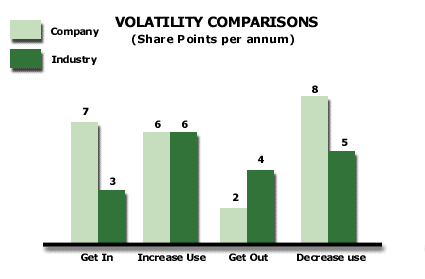Analysis 28: Company Volatility Compared to Industry Volatility
EXHIBITS:

| HOW TO INTERPRET THE ANALYSIS: The exhibit indicates that the industry as a whole had Positive Volatility of 9%, made up of 3% "Get In" and 6% "Increase Use." The total industry Negative Volatility is also 9%, made up of 4% "Get Out" and 5% "Decrease Use." The company's Positive Volatility was 13% made up of 7% "Get In" and 6% "Increase Use." The Positive Volatility of 13% exceeded the Negative Volatility of 10% for the company, made up of 2% "Get Out" and 8% "Decrease Use." So the company gained share in the market on the basis of its performance on Net Volatility. The company outperformed the industry in "Get In" and "Get Out", performed the same as the industry on "Increase Use" and did worse than the industry on "Decrease Use".
The performance numbers for the company do not mean that it was gaining a net of three share points in a year in the industry. Rather, it indicates that its Volatility on its customer relationships enabled it to increase the growth rate of its sales on its customer relationships by a net of 3% of its own customer sales. In order to know what this meant in terms of market share for the industry as a whole, we would have to know the market share of the company in its industry. For example, if its market share were 33%, then its 3% per annum Net Positive Volatility performance on its own sales amounted to a 1 percentage point market share gain in the industry as whole. PURPOSE: This analysis compares the company's sources of volatility volume gain and loss against similar measures for the industry. It shows the company the components of volatility and highlights where the company is relatively strong and weak compared to the average competitor in the market. APPROACH: In an industry that has many new customers coming into the market, Positive volatility (Get In and Increase Use) will be larger than Negative volatility (Get Out and Decrease Use). However, in many industries, the total of Positive volatility will be very close to the total of Negative volatility. That will not necessarily be the case for the company and its competitors, individually. The rule at the individual company level is that net volatility, that is, the difference between Positive and Negative volatility, will not be zero. Most companies either gain or lose volume through volatility. The company determines its own volatility with each customer it has served in the past, or is currently serving. The company then translates its volatility numbers into the equivalent of share points for the industry, where 100 points equals the total sales for the company during the period. These share points will then be comparable to share point changes for the industry as a whole. The industry figures are calculated in a similar manner. Ideally, all share points should be in units. If units are difficult to collect and analyze, then the company can use dollar sales figures instead. For more detail on the calculations needed for this analysis, see Analysis 27: Additional Approach Information to Separate Effects of Customer Growth and Company Volatility. Return to Diagnose Segments: Company Share Change and Volatility |
|
Recommended Reading |
| For a greater overall perspective on this subject, we recommend the following related items:
Analyses: Symptoms and Implications: Symptoms developing in the market that would suggest the need for this analysis.
Perspectives: Conclusions we have reached as a result of our long-term study and observations.
|
